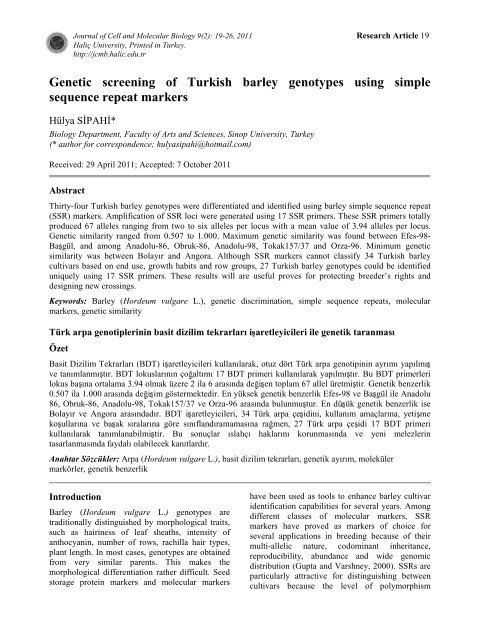Journal of Cell and Molecular Biology - ResearchGate
Journal of Cell and Molecular Biology - ResearchGate
Journal of Cell and Molecular Biology - ResearchGate
Create successful ePaper yourself
Turn your PDF publications into a flip-book with our unique Google optimized e-Paper software.
<strong>Journal</strong> <strong>of</strong> <strong>Cell</strong> <strong>and</strong> <strong>Molecular</strong> <strong>Biology</strong> 9(2): 19-26, 2011 Research Article 19<br />
Haliç University, Printed in Turkey.<br />
http://jcmb.halic.edu.tr<br />
Genetic screening <strong>of</strong> Turkish barley genotypes using simple<br />
sequence repeat markers<br />
Hülya SİPAHİ*<br />
<strong>Biology</strong> Department, Faculty <strong>of</strong> Arts <strong>and</strong> Sciences, Sinop University, Turkey<br />
(* author for correspondence; hulyasipahi@hotmail.com)<br />
Received: 29 April 2011; Accepted: 7 October 2011<br />
Abstract<br />
Thirty-four Turkish barley genotypes were differentiated <strong>and</strong> identified using barley simple sequence repeat<br />
(SSR) markers. Amplification <strong>of</strong> SSR loci were generated using 17 SSR primers. These SSR primers totally<br />
produced 67 alleles ranging from two to six alleles per locus with a mean value <strong>of</strong> 3.94 alleles per locus.<br />
Genetic similarity ranged from 0.507 to 1.000. Maximum genetic similarity was found between Efes-98-<br />
Başgül, <strong>and</strong> among Anadolu-86, Obruk-86, Anadolu-98, Tokak157/37 <strong>and</strong> Orza-96. Minimum genetic<br />
similarity was between Bolayır <strong>and</strong> Angora. Although SSR markers cannot classify 34 Turkish barley<br />
cultivars based on end use, growth habits <strong>and</strong> row groups, 27 Turkish barley genotypes could be identified<br />
uniquely using 17 SSR primers. These results will are useful proves for protecting breeder’s rights <strong>and</strong><br />
designing new crossings.<br />
Keywords: Barley (Hordeum vulgare L.), genetic discrimination, simple sequence repeats, molecular<br />
markers, genetic similarity<br />
Türk arpa genotiplerinin basit dizilim tekrarları işaretleyicileri ile genetik taranması<br />
Özet<br />
Basit Dizilim Tekrarları (BDT) işaretleyicileri kullanılarak, otuz dört Türk arpa genotipinin yapılmış<br />
ayrımı<br />
ve tanımlanmıştır. BDT lokuslarının çoğaltımı 17 BDT primeri kullanılarak yapılmıştır. Bu BDT primerleri<br />
lokus başına ortalama 3.94 olmak üzere 2 ila 6 arasında değişen toplam 67 allel üretmiştir. Genetik benzerlik<br />
0.507 ila 1.000 arasında değişim göstermektedir. En yüksek genetik benzerlik Efes-98 ve Başgül ile Anadolu<br />
86, Obruk-86, Anadolu-98, Tokak157/37 ve Orza-96 arasında bulunmuştur. En düşük genetik benzerlik ise<br />
Bolayır ve Angora arasındadır. BDT işaretleyicileri, 34 Türk arpa çeşidini, kullanım amaçlarına, yetişme<br />
koşullarına ve başak sıralarına göre sınıfl<strong>and</strong>ıramamasına rağmen, 27 Türk arpa çeşidi 17 BDT primeri<br />
kullanılarak tanımlanabilmiştir. Bu sonuçlar ıslahçı haklarını korunmasında ve yeni melezlerin<br />
tasarlanmasında faydalı olabilecek kanıtlardır.<br />
Anahtar Sözcükler: Arpa (Hordeum vulgare L.), basit dizilim tekrarları, genetik ayırım, moleküler<br />
markörler, genetik benzerlik<br />
Introduction<br />
Barley (Hordeum vulgare L.) genotypes are<br />
traditionally distinguished by morphological traits,<br />
such as hairiness <strong>of</strong> leaf sheaths, intensity <strong>of</strong><br />
anthocyanin, number <strong>of</strong> rows, rachilla hair types,<br />
plant length. In most cases, genotypes are obtained<br />
from very similar parents. This makes the<br />
morphological differentiation rather difficult. Seed<br />
storage protein markers <strong>and</strong> molecular markers<br />
have been used as tools to enhance barley cultivar<br />
identification capabilities for several years. Among<br />
different classes <strong>of</strong> molecular markers, SSR<br />
markers have proved as markers <strong>of</strong> choice for<br />
several applications in breeding because <strong>of</strong> their<br />
multi-allelic nature, codominant inheritance,<br />
reproducibility, abundance <strong>and</strong> wide genomic<br />
distribution (Gupta <strong>and</strong> Varshney, 2000). SSRs are<br />
particularly attractive for distinguishing between<br />
cultivars because the level <strong>of</strong> polymorphism

















